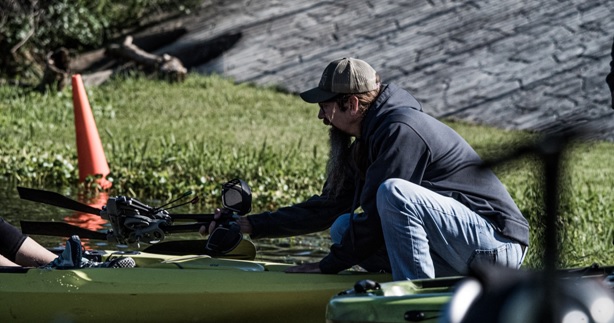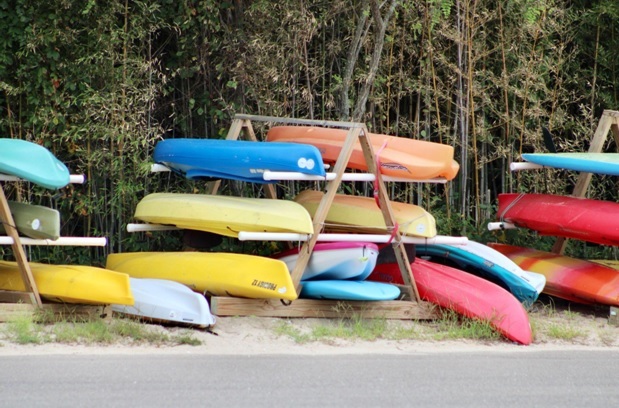Posted by Forrest on Jan 23rd 2024
Seasonal Kayak Maintenance 101
Most fishing kayaks are made with high-quality, durable, high-density polyethylene that is UV-protected and resistant to impacts. Many of them are designed to last for many years.
Still, when you haul her out at the end of the season, you’ll do anything you can to protect your investment so you’ll be ready to shove off next spring, right?
Here’s your primer for seasonal kayak maintenance, specifically for when she’s drydocked in the winter.
Drain and Dry
First things first, don’t just leave your kayak lakeside. When you land the vessel, remove the scupper plugs to let any water drain out of/off the deck, then leave the kayak for a while to ensure that the kayak is dry before storing.
Lubricate All Moving Parts
If you have a kayak with a pedal-driven drive system, like a Hobie Angler Pro 14 or a Jackson Knarr, you’re going to want to remove it.
Most fishing kayaks with these drive units are designed so that the units are easily removable. Dry them thoroughly, then hit the moving parts with an appropriate lubricant before storing somewhere covered, cool, and dry.
Some fishing kayaks also have rudder systems that are controlled via cables. These need to be rinsed clean, dried, and lubricated; in some cases, you might also want to use a protectant or a water displacer to keep rust away.
Remove and Clean the Seating
Some fishing kayaks are made with webbed/stitched seating that is quick drying, comfortable, and UV-resistant. Still, you want to remove the seating to protect it against damage during the off season. Store it with the drive system so you know where both of them are.
Apply a UV Protectant
You shouldn’t store your fishing kayak uncovered, but if you do, you’re going to want to apply a UV protectant.
Most PE (polyethylene) fishing kayaks are already UV-protected, but this finish will wear off with progressive sun exposure.
At the end of each season (or at the beginning, either works) treat the hull and deck with an appropriate UV-protectant agent that will help prevent the deterioration of the polymer.
Inspect All Lines and Deck Fittings
Deck lines, largely made of polymer materials, can not only be damaged by abrasion, but by prolonged exposure to UV light. At a certain point, they will become brittle and break apart.
Replace any damaged bungee lines or tie downs at the end of each season, as well as deck fittings which can also be damaged by sunlight. Repair or replace as necessary so you aren’t met by any unwelcome surprises at the beginning of next season.
Inspect, Protect, or Remove and Replace Ailing Hardware
Cleats and other deck accessories are usually affixed via hardware, generally screws. Inspect these on a close level before winterizing your kayak.
While they’re often made with corrosion-resistant fittings, sometimes hardware still rusts in place. If you detect any rust, remove the affected part and replace the hardware - otherwise it will seize or corrode out and you’ll lose a bit of your yak when you least expect it.
Address or Repair Gouges
Before storing the kayak for the winter, check out the bottom of the hull. There could be some deep gouges in there, from contact with rocks, piers, and other obstacles.
Usually, PE kayaks that get gouged will have two raised ridges along the sides of the gouge. These can be easily removed with a razor blade.
Keep Her Covered, Off the Ground, and Upside-Down
Once you’ve cleaned, dried, and removed the propulsion system from the kayak, find a place to store her over the winter.
Ideally, this place should be dry, off the ground, and out of the elements. In a shed is great, but if you don’t have one, just get a saw horse and a waterproof tarp. Flip her upside down, rest the gunwales on the saw horses, cover with the tarp, and weigh down the tarp edges so they don’t go anywhere.
Special Notes for Motorized Models like the Old Town Autopilot 120
Some kayaks, like the Old Town Autopilot 120, are equipped with a battery-powered drive system that is fast and efficient in both fresh and saltwater.
With that said, kayaks like these need a little more care and attention than their pedal and paddle-powered counterparts due to their sensitive electrical components.
Here are some additional tips.
Remove and Maintain the Battery
Do not store the battery outside with the kayak. Remove the battery, hook it up to a maintainer/trickle charger, and store it in a cool, dry location that ideally won’t drop below freezing. Also, never allow a marine battery to remain dead for long or that will severely and adversely affect its performance and lifespan.

Remove the Drive System
Any fishing kayak that has a battery-powered drive unit installed will need to have it removed before the season is over.
At the end of the season, rinse off the drive unit and allow it to fully dry. Then remove it, check the prop for weeds and line (remove them where you encounter them) and tighten the prop nut.
Finally, lubricate the drive shaft that runs down to the propeller and lower drive unit before storing it out of the elements; you can store it near the battery and seat if you have those in a shed, attic, garage or basement.
Lubricate Moving Parts and Protect Electrical Connections
Any other moving parts should be lubricated, and this is a good opportunity to protect any exposed electrical connections, such as the battery terminals. Coat these with a treatment of dielectric grease to insulate them as well as to protect them against corrosion.

Time for a New Fishing Kayak?
Whether you’ve had your eye on a new Hobie or a battery-powered fishing kayak like an Old Town Autopilot 120, we have them here.
Take a look through our online catalog and contact us directly if you have any questions. Also, keep these tips in mind for future seasonal maintenance and storage, as they will help you protect your investment.

